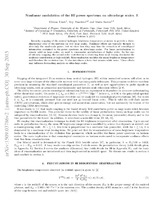| dc.contributor.author | Umeh, Obinna | |
| dc.contributor.author | Maartens, Roy | |
| dc.contributor.author | Santos, Mario G. | |
| dc.date.accessioned | 2015-10-27T12:05:12Z | |
| dc.date.available | 2015-10-27T12:05:12Z | |
| dc.date.issued | 2015 | |
| dc.identifier.uri | http://hdl.handle.net/10566/1911 | |
| dc.description.abstract | Intensity mapping of the neutral hydrogen brightness temperature promises to provide a three-dimensional view of the universe on very large scales. Nonlinear effects are typically thought to alter only the small-scale power, but we show how they may bias the extraction of cosmological information contained in the power spectrum on ultra-large scales. For linear perturbations to remain valid on large scales, we need to renormalize perturbations at higher order. In the case of intensity mapping, the second-order contribution to clustering from weak lensing dominates the nonlinear contribution at high redshift. Renormalization modifies the mean brightness temperature and therefore the evolution bias. It also introduces a term that mimics white noise. These effects may influence forecasting analysis on ultra-large scales. | en_US |
| dc.language.iso | en | en_US |
| dc.publisher | IOP Science | |
| dc.rights | This is the author version of an article that has been archived at http://arxiv.org/abs/1509.03786. A second version of this article has also been archived at http://arXiv:1509.03786v2. | |
| dc.source.uri | http://arxiv.org/abs/1509.03786 | |
| dc.subject | Nongalactic Astrophysics | en_US |
| dc.subject | Cosmology | en_US |
| dc.subject | Neutral hydrogen (HI) | en_US |
| dc.subject | non-Gaussianity | en_US |
| dc.subject | Forecasting analysis | en_US |
| dc.title | Nonlinear modulation of the HI power spectrum on ultra-large scales. I | en_US |
| dc.type | Article | en_US |
| dc.privacy.showsubmitter | false | |
| dc.status.ispeerreviewed | true | |

